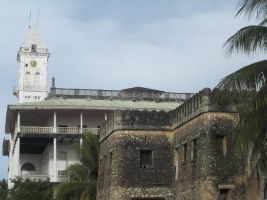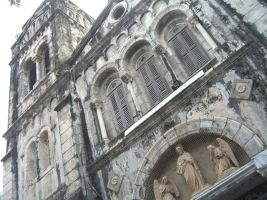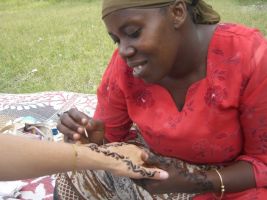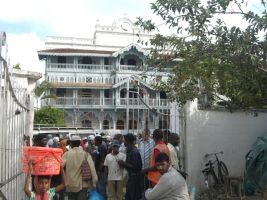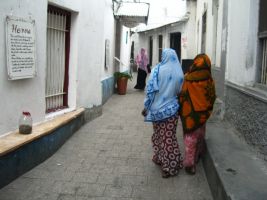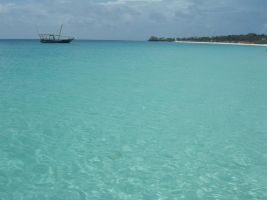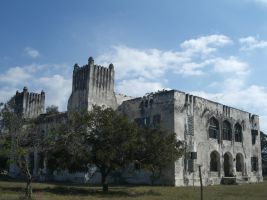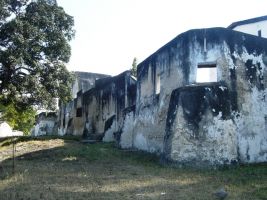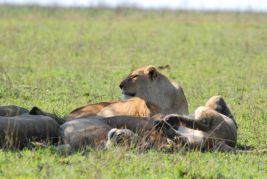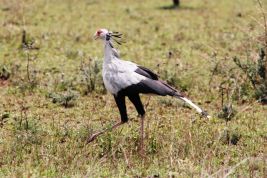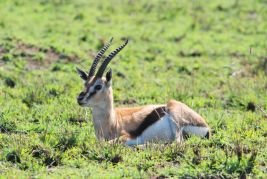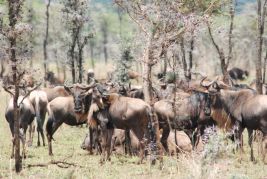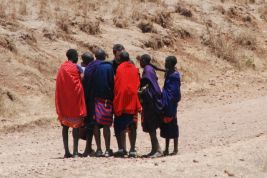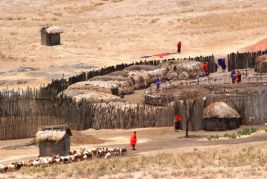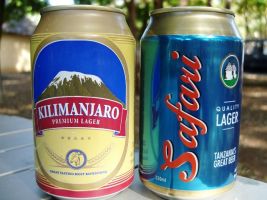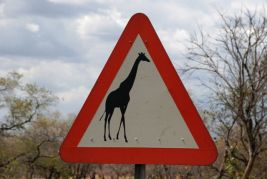
 Italia
Italia France
France Spain
Spain Morocco
Morocco Mauritania
Mauritania Senegal
Senegal Mali
Mali Burkina
Burkina Ghana
Ghana Togo
Togo Benin
Benin Nigeria
Nigeria Cameroon
Cameroon Gabon
Gabon Sao Tomè
Sao Tomè Gabon 2
Gabon 2 Congo
Congo Congo DCR
Congo DCR Angola
Angola Namibia
Namibia Sud Africa
Sud Africa Namibia 2
Namibia 2 Botswana
Botswana Zimbabwe
Zimbabwe Botswana 2
Botswana 2 Sud africa 2
Sud africa 2 Swaziland
Swaziland Mozambico
Mozambico Malawi
Malawi Tanzania
Tanzania Rwanda
Rwanda Uganda
Uganda Kenya
Kenya Etiopia
Etiopia Sudan
Sudan Egitto
Egitto Libia
Libia Tunisia
Tunisia Malta
Malta
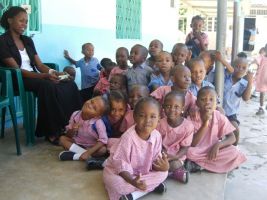
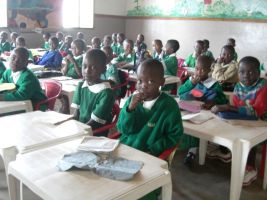
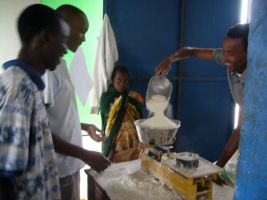
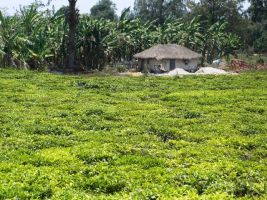
Karibuni Tanzania - 5 Oct 2008
Karibuni means welcome in…Tanzania. After leaving the Malawian frontier, we pay $50 to the immigration dept. for a three-month Visa; we also pay $25 for road tax. We then find an ‘official’ in a wooden shack, who gives us a COMESA Yellow Card, insurance that supposedly covers us throughout the states we intend to cross - including Egypt. He forgets to write the expiry date and there is no policy number on the document.
We doubt the validity of this policy, but we are happy to have something to show to the police.
This land, in this part of Tanzania is particularly fertile: we find bananas, tea, maize and papaya in abundance.
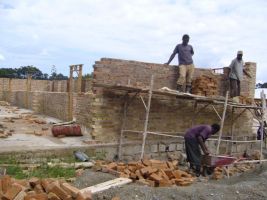
Mafinga – 6 Oct 2008
We reach this mission and find Sister Gabriellina from Modena, Father Pio from Treviso and Father Gabriele from Cuneo. They have set up this clinic with an outpatient facility to assist pregnant women. Along with the handing-out of blankets, they can receive seeds to plant and small animals to rear, to help in feeding their families. A group of women with AIDS are closely supported and more than 100 orphans are helped (all details in the solidarity section).
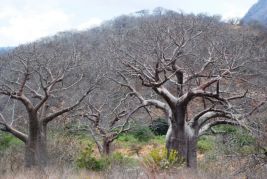
Baobab Forest
We cross one of the most arid areas in Tanzania. Only a thick baobab forest gives interest and fascination to the area.
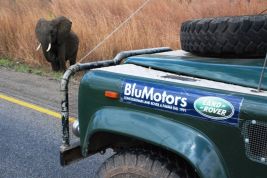
Mikuni Park – 6 Oct 2008
Not regarded as one of the most famous parks, but along the asphalted road that passes through it, we witness a great variety of animals: giraffes, buffalos, antelopes, monkeys and elephants.
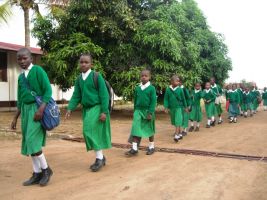
Morogoro – 7 Oct 2008
Marta Rizzo, is a doctor we met back in Mozambique, she had suggested we pay a visit to the S. Teresa School and Orphanage. We visit the large building built in an area of very arid soil that was once without vegetation. Now it boasts a nursery, a primary school and a place to stay for those orphans and students who live a long way from the school.
We leave an Elfo token (more details in the solidarity section).
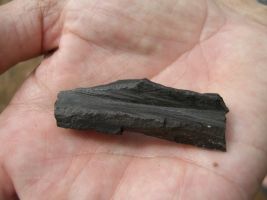
The Black Stone
This piece of stone, is believed to cure very poisonous snakebites (we do not know the percentage of success). It apparently absorbs the poison; the stone is regenerated by soaking it in milk or in salted boiling water.
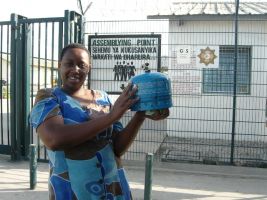
Dar Es Salaam - 7 Oct 2008
Here we are in the big city. With Anna’s help, we manage to fill up the gas tank that we finished back in Namibia. We couldn’t get any in South Africa, Mozambique, Botswana, Malawi or Swaziland as the coupling is different. Here the fitting is right, but we needed to be able to speak Swahili.
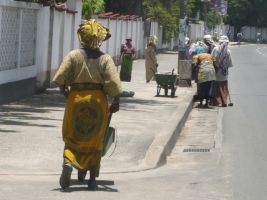
We apply for the Visa for Egypt, paying the equivalent of 15-euro. We need to be at the frontier within three months. They tell us that there isn’t an expiry date for Italians, but on the Visas, they write “one month”... we will see. We then get a Visa for $60 from the Rwandan Embassy in just 24 hours. The secretary, from Tutzi origins, is very polite; her parents were refugees that have now come back to this country. We also pay a visit to the Italian Embassy, where the staff were most welcoming.
We had noticed for the first time in Malawi and now here, the presence of female garbage collectors or dust-women.
Zanzibar
Just the name evokes stories of adventures; periods of discovery and the memories of old markets; painful stories of violence and the slave trade; romantic stories of explorers from the 800’s and determined missionaries.
Throughout African history, Zanzibar is as famous as Timbuktu, always vivid in our fantasies as both a cursed and wonderful place.
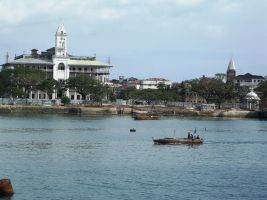
We take a quick ferry instead of the boat (just one hour and a half as opposed to three hours by boat): $70 each for a return ticket. We get to the Port and learn that the ferry has a problem with its engine. We wait an hour before we leave… two hours and forty minutes later; we disembark at the island port. So, what is the difference between the ferry and the boat? - The boat probably takes five hours. We stop off in Stone Town, a mix of Arabian, Persian, and Indian styles and not many true locals. It feels like being in the Middle East, down to the henna tattoos reminding you even more of the Arabian culture.
Since the year 1000, the Omani have been here trading in spices, ivory, textiles and slavery, half a millennium before the first white person (from Portugal) appeared. The women are tall and slim, and very elegant in their dark colours and their overlapped transparent veils; only the colour of their skin is in common with the African women of the coast.
The sea is wonderful, abound with colourful fish, the beaches are white and sandy, a paradise ideal to lure the tourists.
We also enjoy this paradise for a day, with the pleasant company of few friends we met in the Capital: Eva, who works for the Embassy, Mario and Ombretta and their families involved in an International Co-operation Project.
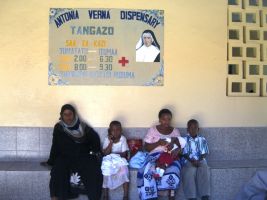
Kawe – 13 Oct 2008
Our holiday is short lived and after just two days we hit the road again. We are feeling a little exhausted, so as precaution, to make sure it isn’t Malaria, we take advantage of a clinic in Kawe set-up and run by the Sisters from Ivrea, Italy; the results of blood tests are negative. We decide to take a stroll around the centre and visit a well-organized nursery where we donate an Elfo token (details in the solidarity section)
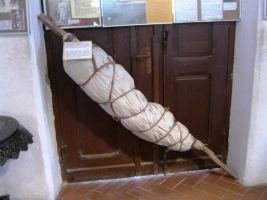
Bagamoyo – 14 Oct 2008
Caravans on expeditions would group together and depart from this coastal region; also, the “dhows” - sailing boats with typically triangular shaped sails - carrying goods and people, heading for the port in Zanzibar.
It was also, where Arabian slave hunters rounded-up the many sad caravans of chained, naked men, women and children destined for the Eastern markets. Often kidnapped around the areas of the Tanganika Lake, they then had to endure a 1200km walk under much duress and whipping from their captures. Two centuries later, Burton and Speke travelled throughout this region in search of the head from which the river Nile emerged.
Stanley in search of Dr. Livingstone, who was brought back to this land, his embalmed body, wrapped around a post and carried for 1500km over 9 months by his devoted bearers. This place has witnessed hundreds of missionaries, explorers, adventurers and businessmen without scruples. Arabs, Portuguese, English and German have disputed this land.
Today, in decline, this village has an incredible history.
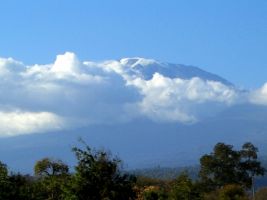
Kilimanjaro -15 Oct 2008
We arrive at the foot of Mount Kilimanjaro (but without Licia – famous Italian T.V. personality)
We stop at the Key’s Hotel and camp in their car park for $20 including breakfast.
GPS S3° 20.307’ E37° 20.813’
From here, you can begin your ascent of the highest mountain in Africa, Kilimanjaro; it is six-days to the summit. We cannot decide if we will climb it or not, it’s a big decision… I suppose since we are here, then why shouldn’t we?
1) The price is $1000 a head; plus the tips you are obliged to give to the carriers (you’re even supplied with a chart on how much to tip them)… how ridiculous… (Instead of the Government protecting them, they are exploited along with the tourists - who are charged an extortionate price and then are asked to supplement the carriers poor wages with tips; incidentally, these carriers are treated no less than slaves! Incredible!)
2) It will take a week, the rainy season is upon us, plus the visas for Egypt expire in less than three months, this isn’t very good.
3) We spend most of the time sitting in the car; therefore, we have had a lack of exercise.
4) The boots we have are not suitable for snow and icy conditions, therefore, too dangerous.
5) The weather is variable and chances are, you climb all that way just to be faced with dense fog.
We decide not to climb; best we stand back and just admire it.
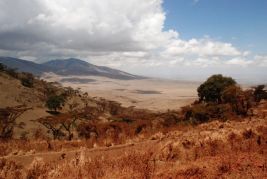
Arusha – 15 Oct. 2008
We travel through Arusha, along the road of this village, it is full of demanding people; however, we need to stop and pick-up some supplies that we will not be able to get further on. We are 100km from Kenya and we have uneasy feelings heading towards Rwanda; as a marathon runner who gets to the 35th km - 500m from the finish line, only to find the track takes him around a 7km circuit.
We ask for information at the Tourist office and we are told that the road to Rwanda is full of bandits and drifting refugees, in other words, very dangerous. There are over 300km of isolated forest between the State border; furthermore, a restaurant manager, who tells us a different story, contradicts this.
For $10, we sleep at Masai Camp, nice and cheap … African standard. During the night, three security guards armed with baseball bats and shotguns patrol the entrance. GPS S3° 23.116” E36° 43.188”
The next day, we carry on and we get to Karatu, outside the gate “the life crater”. We sleep at a very simple but clean campsite: Ngorongoro Camp. (10$)
GPS S3° 20.696” E35° 40.000”

Ngorongoro – 16 Oct 2008
This is the name of the crater and it is home to many wild animals. This unique place in the world is reached by an unpleasant dirt track. Once at the craters edge, you can admire the beautiful animals that live in it. You need to cross Ngorongoro Park to reach the Serengeti Park. A day in Ngorongoro Park costs $50 each, plus $40 for the vehicle, in total, $140 just for a 24-hour permit. If you wish to enter the crater (exclusively with a 4x4), you need to pay a further $200 for a single permit, a total of $340 per day!
If you want to camp, you will need to add another $60 for two persons, but you must exit within 24 hours of entering; if you are just ten-minutes late, you are charged a further $140 day charge; the total cost for one day included camping comes to $400. If, like us, you have already visited the wonderful and economic parks in South Africa and Botswana, then this ‘money spinner’ can be avoided.
Considering the fees, we decide to cross the park only, leaving-out entering the crater or campsite (the campsites have a bad reputation - poor services and no water), we manage to spend “only” $140.
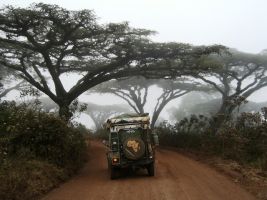
Shit-Day - 17 Oct. 2008
Today is the “crater of life” - Ngorongoro. We get up early to make the most of the day and reach in good time the Serengeti Park, an adjacent park with many more animals. Dark, black clouds cover the sky and, it is raining. What a nice start! Hopefully, the weather will improve. We arrive at the gate, pay and enter the park. The track is one of the worst we have encountered on this trip, a dirty track full of potholes. It is raining and visibility is poor. We make the journey slightly longer by driving by the edge of the crater, but conditions do not improve. You could easily be facing Cinisello Balsamo on a November morning. In a brief clearing in the sky, we take a picture of K7 in the woods. We cannot see anything else.
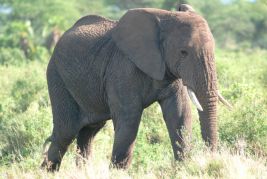
After nearly three hours, we decide to abandon the high area and head towards the Serengeti. Further down, the rain seems to have stopped and the sun is out. Fortunately, we are still able to see the crater which from here, doesn’t look like a crater but is like a wide valley surrounded by mountains… with the exception of some elephants and giraffes there are no striking wild animals to be seen.
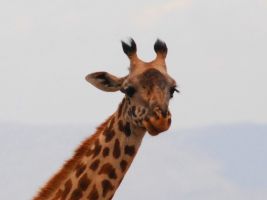
Further down, layers of dust and pebbles cover the track. It hasn’t rained here, and we are soon as white as millers. It is so hot and quite unbearable. We switch-on the air conditioning; the belt makes an unpleasant noise. Maybe it’s just catching on something, or maybe the belt is old and needs replacing, or maybe the compressor is seized and the belt can’t pull… maybe… to hell with maybe!
We will have to turn the air conditioning off and rely just on the front air-vents.
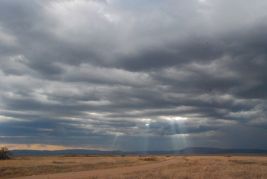
We arrive at the gate, which separates the two parks. We leave Ngorongoro NP and we enter Serengeti NP. Obviously, with a new park comes a new fee. We pay $140 again for the 24 hours and $60 for the campsite. $200 from 4p.m. to 4p.m. tomorrow (today we have already spent $340!)
We drive again on terrible tracks.
The road is shameful, not even in Angola or Gabon have we travelled on roads in such terrible condition, we manage an average speed of 20km/h over the 170km journey. The hired cars zoom past at 50km/h. the suspension on these vehicles do not need to carry their drivers back to Italy; furthermore, these fast drivers do not have to fork-out for spare parts.
We wonder where all the money they get from the tolls goes; all that money that the countless tourists leave every day visiting these parks, where does it go? God only knows… but perhaps we have an idea…
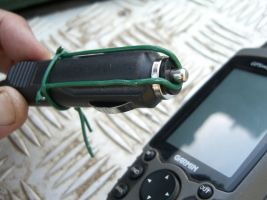
The weather gets worse, it starts to rain and it is getting dark. By 6 o’clock, it is dark and we are in now in torrential rain with just 10 minutes from the campsite. I will pass over the wonderful details of camping and cooking under a torrent of water. To add further insult to injury, we find that due to vibration, the GPS mains connector has not only detached itself but has also seen fit to fall apart. We find all the pieces apart from one, and you no what, we probably never will, not in the dark, with dinner to cook, exhausted and completely covered in grime…what a day!
We pay the campsite as you would for a stay at the “Grand Hotel de la Ville”; the place is full of tourists, waiting for their “slaves” to set up their tents and cook their meal…. and, there isn’t a bathroom to have a shower.
- And what are you looking at? We are on a trip around Africa don’t you know… Is this really your dream? Lovely, isn’t it? Yeah…great!
The next day, under a blue sky, I use a little ‘African improvisation’ to repair the connector; let’s hope it lasts… off we go!
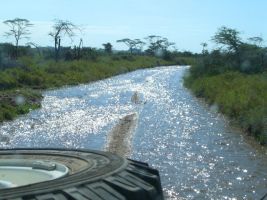
Serengeti NP – 17 Oct. 2008
This is most definitely a beautiful park, lovely landscape and many animals. It isn’t a park for car owners (in fact, the exact opposite of Kruger Park in S.A.); the roads are appalling with little or no maintenance.
The daily cost for two foreigners with car including campsite is $200. For the locals, it would be 100 times less. The result: By buying a package from the local agency, you spend the same, but you stay in a lodge and not on a campsite. Furthermore, you also have a guide who knows where the animals are and where the terrain is suitable. Moreover, if the vehicle breaks down, it is not your problem. After the previous day’s rain, the tracks are quite inaccessible.
Besides elephants, zebras, many types of gazelles, giraffes, hyenas, jackals, numerous species of birds and storks, hippos and warthogs, for the very first time we have seen the Thompson gazelle, very similar to the Springbok of South of Africa, and we have witnessed the start of Gnu migration… in their many thousands.
The Masai
This population, who also live in the park on the Kenyan side (the park here is called Masai Mara), are sheep-farmers. Their traditions are very old; they wear colourful clothes and have very particular customs and food. They are protected from most things - apart from the devastating tourist culture. Nowadays, many youngsters, who have to look after cows and goats, prefer to sell gadgets to tourists or have themselves photographed or beg rather than dedicate their time to their livestock.
The Masai population is of antique origins that, little by little, are in the process of disappearing.
We believe there should be heavy penalties similar to the penalties for feeding and mistreating the wild animals. It would deter those who choose to give pens, coins or “gifts” to the Masai.
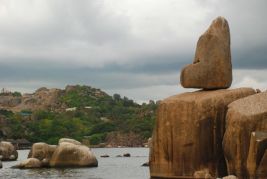
Mwanza- 18 Oct 2008
Mwanza is located on the South bank of Lake Victoria, a place discovered in the mid 1800’s by Speke. From here, in 1871 the first courageous team led by Stanley departed to explore the lake coasts. By boat, they travelled around the biggest African and second largest lake in the world. Here, there are lovely smooth, round rocks. We camp at the Yacht Club by the lake.
GPS S2° 31.745’ E32° 53.652’.
In the meantime, we are after information about the security of the road from here to the border. This forest zone is where there used to be many refugee camps, there are many bandits, who stop and steal cars. You need to be very careful when asking for information; you must not give too much away on where you are going.
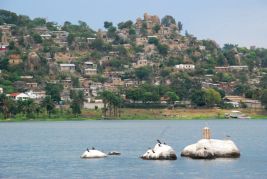
As usual, the information is mixed, from the very reassuring to the very worrying. We decide to leave early and take the first ferry out, which will take us to the other side of the lake where the city is. On that side, an awful track heads out towards the west. There are 400 very dangerous kilometres to the Rwandan border, and then there is a further 170km to reach Kigali, the capital. If we don’t waste time, we should be able to do it in a day, it all depends on the road conditions and on whatever else we might face.
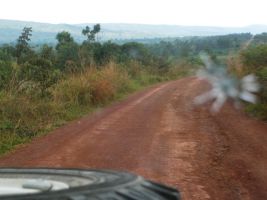
Broken Glass
The ferry to Kamanga leaves right on time. It is a private company and the cost is 6.500 shillings for each vehicle and its driver and 800 shillings for each passenger. (1-euro corresponds to 1.600 shillings).
During the half hour crossing, torrential rain begins, and the river soon becomes a deluge of mud and dirty water. We carry on, so far so good, everything seems to be going well, when we see many people holding machine guns by the road, then, a stone cracks the front glass of our k7, leaving a mark that resembles a star. It has been the third stone that has hit our car during this trip, but this one is the biggest of all.

Container Linee Messina
We get a surprise 20km before the border. Two Lorries block the road ahead; we have no idea when we could get through. Over the last kilometres, our GPS was warning us of armed convoys, with the advice to “carry on and do not stop”. It is 1 o’clock and we end up stuck here for four hours, then all of a sudden, we are on the move again. Customs close at 6 o’clock; therefore, we rush towards the border knowing that after that, we would have another 170km to reach the Rwandan capital Kigali.
At 6 o’clock, it is already dark, and in Africa, it is not advisable to drive after dark.
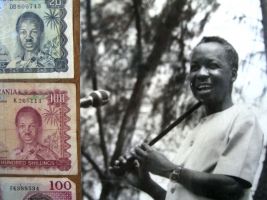
Julius Neyrere
We wish to publish a picture to honour this great African president. It is rare to find a person of such virtue in the African political scene. Comparable to the moral power of Nelson Mandela. With and without all the mistakes that a good politician can make, a man who has given dignity and a future to Tanzania. Dignity and future hopes that the current governors are slowly losing.
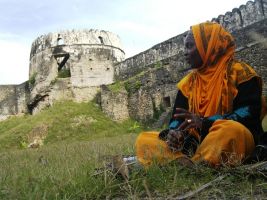
Our Impressions
We didn’t particularly like Tanzania.
The place is lovely and is rich in history, and all in all its security is good; however…
The roads are in terrible condition, very bumpy, too much so in a place this small. Speeding limits are between 30 and 50km/h, you would destroy the car if you should attempt these speeds.
We didn’t like police officials, once again soliciting for tips and gifts, contrary to the teachings of their traditions.
Tanzanians are not very friendly and are persistent in their requests for money or their finding ways to make it.
We didn’t like the tourist policy of shamelessly high prices and the total commitment to organized trips.
We are quite happy to leave a place so bent on ripping-off the tourist.
